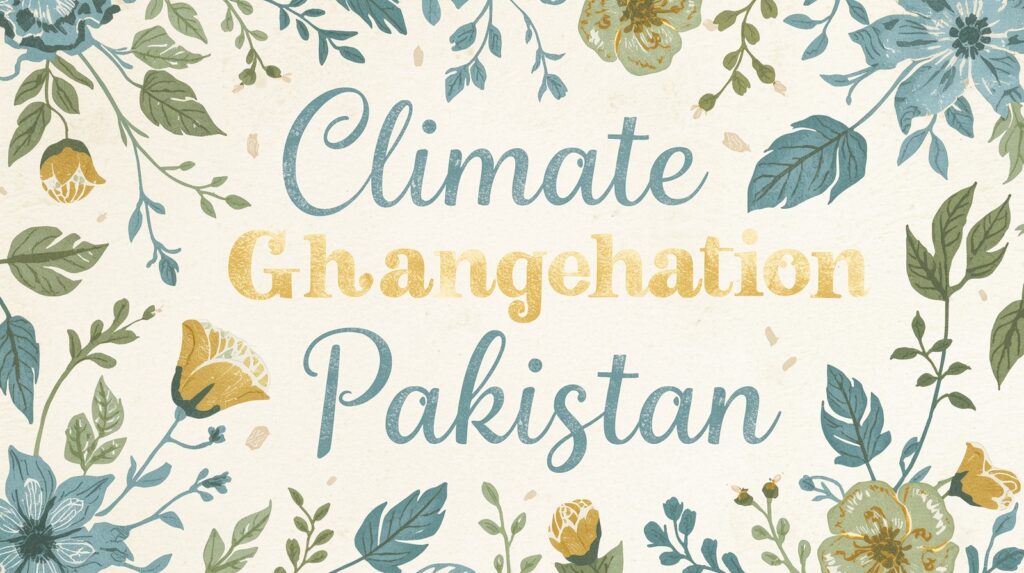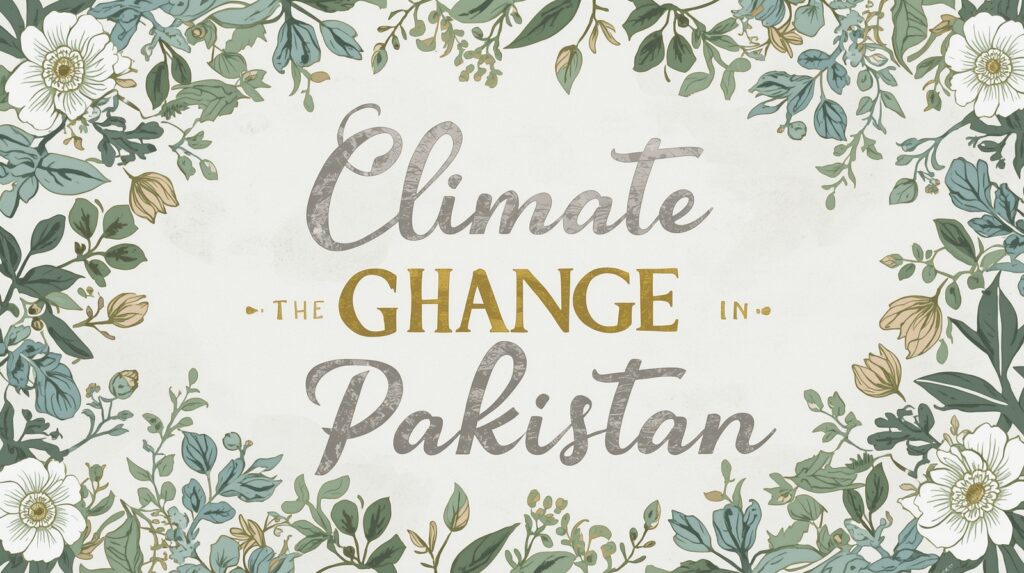In 2025, Pakistan is at the crossroads of a growing global emergency – climate change. Once seen as a distant concern, it is now an everyday reality for millions of Pakistanis. From deadly floods and searing heatwaves to glacier melt and air pollution, the repercussions of climate change are obvious across every province. Pakistan, a country that contributes less than 1% to global greenhouse gas emissions, is paying one of the highest fees for a catastrophe it did not create.

A Fragile Land Facing Fierce Forces of Nature
Pakistan’s geography makes it especially vulnerable to the changing climate. Stretching from the frigid heights of the Himalayas to the balmy shores of the Arabian Sea, the country’s diversified geography faces several dangers simultaneously.
In the north, melting glaciers are feeding rivers at an alarming rate, raising the risk of glacial lake outburst floods (GLOFs). In the south, increasing sea levels are swallowing parts of the Sindh coastline, forcing fishing populations to migrate inland. Meanwhile, Balochistan’s deserts are expanding, and Punjab’s farmland faces declining productivity due to erratic rainfall.
According to Pakistan’s Ministry of Climate Change, over 150 climate-related disasters have hit the country in the past two decades. The most destructive of them was the 2022 floods, followed by the 2025 floods, which together displaced millions and cost billions in damages.
The Human Cost of a Changing Climate
Behind every climate statistic lies a human tale. Farmers in Sindh and Punjab are witnessing their crops destroyed by floods or droughts. In Karachi and Lahore, record-breaking heatwaves have made daily life intolerable, with temperatures touching 50°C (122°F) in certain locations.
Rural families are being forced into poverty as agriculture — the backbone of Pakistan’s economy — becomes increasingly unreliable. Water scarcity in southern Punjab and Balochistan has triggered migration toward cities, producing new social and economic difficulties. The World Bank estimates that by 2030, around 10 million Pakistanis could be displaced due to climate-related disasters.
Floods, Droughts, and Heatwaves: The Triple Threat
- Floods: Every monsoon brings terror instead of relief. The 2025 floods were a terrible reminder that Pakistan’s drainage and disaster management systems are still underdeveloped. Urban flooding in Karachi, Hyderabad, and Lahore has become a chronic issue due to uncontrolled building and dammed rivers.
- Droughts: In contrast, the country’s western and southern regions — notably Tharparkar and Cholistan — are enduring protracted dry spells. These droughts lower animal numbers and jeopardize food security for millions.
- Heatwaves: The increased intensity of heatwaves is frightening. Schools, businesses, and even hospitals have been forced to close during peak summer. According to the Pakistan Meteorological Department, the frequency of extreme heat occurrences has doubled in the last decade.

Environmental Degradation and Air Pollution
Climate change is not the only environmental concern Pakistan faces. Air pollution in metropolitan centers has reached alarming levels. Lahore, formerly called the “City of Gardens,” today routinely tops the global list of cities with the worst air quality index (AQI).
Deforestation is another quiet issue. Pakistan’s forest cover is less than 5%, well below the global average. Illegal logging, population growth, and urban expansion have contributed to this alarming loss, weakening the country’s ability to absorb carbon dioxide and prevent soil erosion.
Economic Impact: Billions Lost Each Year
The economic burden of climate change in Pakistan is astounding. The Asian Development Bank (ADB) estimates that Pakistan loses around $3–5 billion annually due to climate-related impacts.
Floods ruin roads, bridges, and crops; droughts impair livestock and agricultural produce; and high heat limits productivity. The cumulative result is slower GDP growth, greater unemployment, and increased inflation – all of which directly hurt ordinary folks.
Small companies and farmers suffer the hardest. With limited access to insurance and financial support, many families find themselves locked in a cycle of poverty following every tragedy.
Government Efforts and Climate Policies
Recognizing the mounting threat, the Government of Pakistan has taken significant initiatives toward climate change. The National Climate Change Policy and Pakistan Climate Change Act provide a framework for adaptation and mitigation. Initiatives such as the “Ten Billion Tree Tsunami”, Clean Green Pakistan, and Recharge Pakistan Project attempt to restore ecosystems and enhance water management.
The Rebuild Pakistan 2025 program, launched after the floods, focuses on rebuilding climate-resilient infrastructure — from flood-resistant housing to sustainable irrigation systems. However, implementation remains a challenge due to limited funding, political instability, and lack of coordination among provinces.
The Role of International Support
Given Pakistan’s tiny contribution to global emissions, international support is important. The United Nations, World Bank, and IMF have recognized Pakistan as one of the top victims of climate injustice. The COP28 and COP29 conferences stressed the need for climate funding for vulnerable nations.
In 2025, Pakistan obtained fresh commitments from the Green Climate Fund to help build renewable energy projects and update disaster management systems. Countries including Germany, China, and Saudi Arabia have also promised technical and financial aid for adaption projects.
Renewable Energy: The Road to Sustainability
To minimize its dependency on fossil fuels, Pakistan is steadily shifting toward renewable energy. Solar and wind energy projects in Sindh, Balochistan, and Punjab are expanding rapidly. The government aims to generate 60% of its electricity from clean sources by 2030.
This transformation not only helps cut emissions but also creates jobs and stabilizes the national grid. The rise of solar-powered irrigation systems is particularly useful for rural populations facing water constraint.

What Needs to Change
While Pakistan has achieved progress, much more is needed to assure a viable future. Experts underline numerous urgent steps:
- Strengthen early warning systems for floods and heatwaves.
- Invest in water conservation and storage infrastructure.
- Promote green urban planning to reduce heat islands.
- Educate communities on sustainable methods.
- Empower youth and women to lead local climate projects.
- Strictly enforce pollution control laws in industries and transport. Addressing climate change involves not just government action but also public awareness and collective responsibility.
A Call for Climate Justice
Pakistan’s climate problem is not only a national one – it’s a global one. The country stands as a symbol of climate injustice, absorbing the burden of emissions produced elsewhere. Yet, Pakistan’s perseverance, ingenuity, and community spirit continue to inspire hope.
From young campaigners planting trees to scientists devising sustainable solutions, the people of Pakistan are fighting back – not just for their nation, but for the planet.



